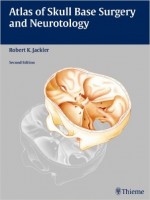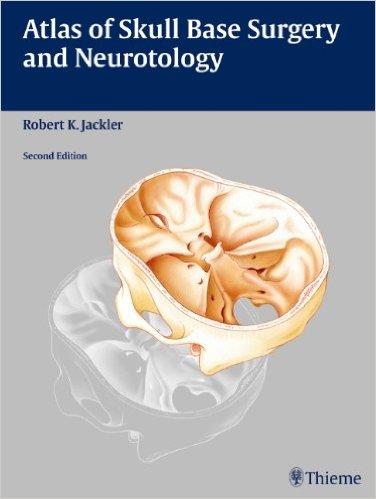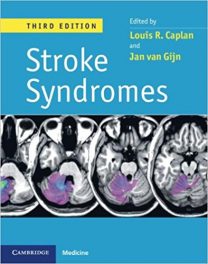 Author: Robert K. Jackler, MD
Author: Robert K. Jackler, MD
Medical Illustrator: Christine Gralapp, MA, CMI
Publisher: Thieme – 268 pages
Book Review by: Nano Khilnani
The author of this book Dr. Robert Jackler, who is a head and neck surgeon or otolaryngologist, states that the reason he wrote this book is to “provide an overview of the technical aspects of operative neurotology and skull base surgery.” Otology being the study of the ear, neurotology, as a subspecialty of otolaryngology, deals with parts of the nervous system relating to hearing, and treats the neurological disorders of the ear.
Using the term skull base surgery is a misnomer, he points out. The purpose of this so-called surgery is not to excise skull base tumors or lesions or treat disease in that area of the head but instead “to provide access to inaccessible intracranial disease located adjacent to the brain stem.” The term transbasal craniotomy is more accurate, he points out.
He explains that the purpose of transbasal craniotomy is “the removal of skull base bone to minimize or eliminate the need for retraction of the brain while providing access at a depth and angle of view favorable for atraumatic microdissection.”
This book is a useful guide to practicing neck surgeons and neurosurgeons, and more so for those undergoing training in these fields, such as residents and fellows. These are some of the most complex and involved fields in medicine, and we assert that this book is an adequate study tool for the following reasons:
- Outstanding credentials of the author: Dr. Robert K. Jackler did his residency in otolaryngology – head and neck surgery (OHNS) – at University of California – San Francisco after completing medical school in Boston. He is a neurotologist with more than 30 years experience, having taken his fellowship in that field in 1985 at the House Ear Clinic. He has been a professor since 2003 and is chairman of the OHNS department at Stanford University School of Medicine. He has written numerous analytical papers in neurotology and in collaboration with medical artist Christine Gralapp, produced over 1500 detailed illustrations
- This book provides the most extensive coverage of many topics in neurotology and skull base surgery that we have seen so far, as shown in the list of chapters below
- This expanded second edition of the book provides over 700 full-color illustrations showing much anatomic detail, operative approaches, and surgical techniques
The range of subject matter covered in this book is quite wide. We believe that in order to do justice to and be fair to intending users of the books we review, we should give them overviews of the content of books, and let them decide if such books would be sufficiently useful to them.
The best way to provide overviews is to list the chapters, or at least the main parts or sections of books. So we present to you below in smaller type a list of chapters of this excellent book that covers many types of procedures and various surgical approaches:
- Surgical and Pathologic Anatomy of Neurotologic and Skull Base Tumors
- Lateral Approaches to the Internal Auditory Canal and Cerebellopontine Angle
- Retrosigmoid Approach to the Internal Auditory Canal and Cerebellopontine Angle
- Microsurgery of Acoustic Neuroma
- Middle Fossa Approaches to the Internal Auditory Canal and Cerebellopontine Angle
- Combined Craniotomies of the Posterior and Middle Fossae
- Microsurgical Resection of a Complex Meningioma via Combined Approach Craniotomy
- Approaches to Jugular Foramen and Infratemporal Fossa
- Far Lateral Approach to the Foramen Magnum
- Approaches to Meckel’s Cave (Cavum Trigeminale)
- Approaches to the Clivus
- Orbitozygomatic Approaches
- Use of Endoscopes in Skull Base Surgery
- Vascular Considerations in Lateral Skull Base Surgery
- Fractures of the Cranial Base
- Encephalocele of the Middle Fossa Floor
- Cerebrospinal Fluid Leak
- Temporal Bone Resection
- Approaches to the Petrous Apex
- Ear Canal Close in Skull Base Surgery
- Facial Nerve Surgery
- Facial Nerve Rerouting during Skull Base Surgery
- Reanimation of the Paralyzed Face
- Vestibular Surgery Cochlear Implantation
- Cochlear Implantation
- Reconstruction of the Cranial Base
- Cranial Nerve Monitoring
This is an outstanding resource in neurotology and skull base surgery, with lots of materials gathered, organized, laid out, expertly written, and presented by a highly qualified and experienced specialist in those fields.
Author:
Robert K. Jackler, MD is Sewall Professor and Chair of the Department of Otolaryngology – Head and Neck Surgery; Professor in the Departments of Neurosurgery and Surgery; and Associate Dean for Continuing Medical Education at Stanford University School of Medicine in Stanford, California.







